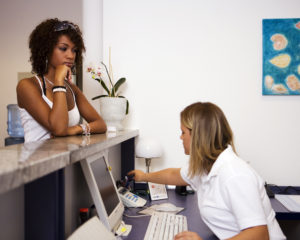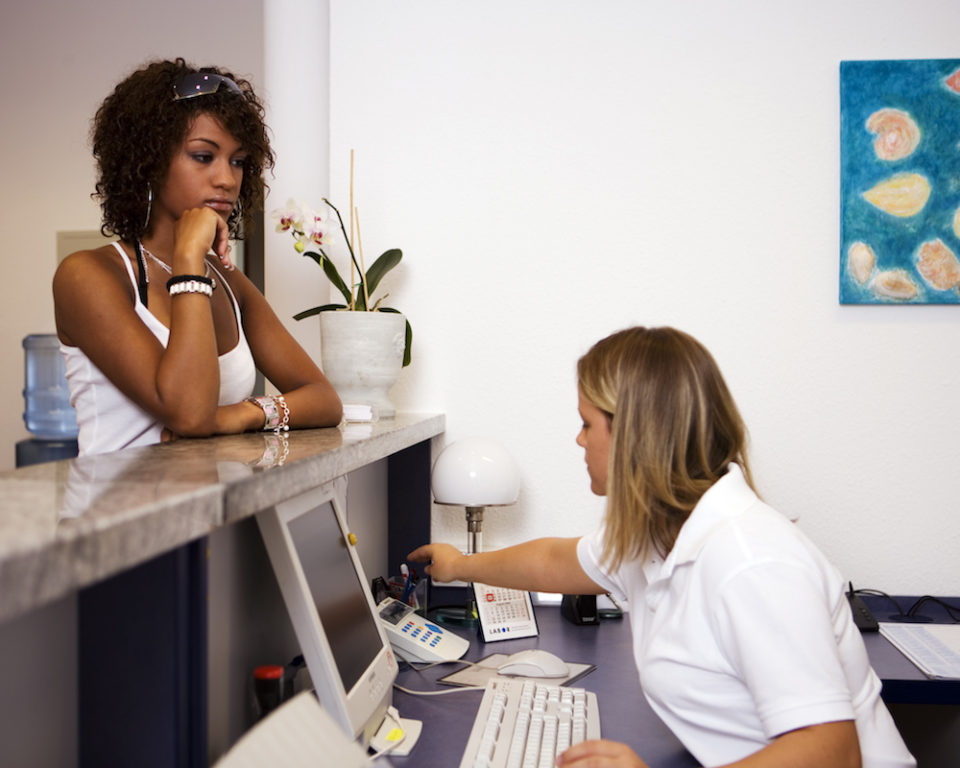 In most practices, reception is the first point of contact your patients will have with you. And while much has been said about the role of reception staff in welcoming people, what about the design, layout, colour and condition of your reception area and desk? Does it matter? Do patients welcome an attractive, inviting entrance? Yes they do – but not as much as your staff!
In most practices, reception is the first point of contact your patients will have with you. And while much has been said about the role of reception staff in welcoming people, what about the design, layout, colour and condition of your reception area and desk? Does it matter? Do patients welcome an attractive, inviting entrance? Yes they do – but not as much as your staff!
Research conducted by the Picker Institute, a not-for-profit organisation that compiles patients’ views to improve healthcare, says that a tidy, well-designed reception space is vital to the whole patient experience, suggesting that first impressions really do make a difference. Indeed, patients consider the built environment of the GP surgery as an important mediator of quality healthcare delivery. So how can you ensure your reception area fits the bill? Here are some ideas put forward by practices – some more obvious than others.
Confidentiality, safety and security: According to the Picker Institute privacy for patients is vital. The reception area was felt by the majority in its survey to be the most important in this regard and the reception desk and its design drew much comment. A wide desk is the obvious answer to this, as is a top ‘shelf’ that allows reception staff to place paperwork underneath, away from prying eyes. In addition, reception areas need to be designed so that receptionists can see patients in waiting room at all times, while hiding all activity behind the desk from patient view. To address privacy issues, try to use a room behind reception where private conversations can be carried out and confidential phone calls made.
Staff safety: Patients don’t tend to like high desks at reception, but they do acknowledge that they are necessary to protect staff from attack – the answer is trying to find a happy medium. It’s worth noting that if desks are deep, then from a security point of view it is difficult for someone to reach staff or clamber over. Consider installing a panic alarm behind the desk as an added safety feature.
Varied heights: One conflict between staff and patient demands revolves around accessibility. Having a reception desk accessible to people in a wheelchair doesn’t sit well with staff security and patient confidentiality. The answer here is to perhaps have different sections on the desk at different heights – known as drop elements in the trade. Try to position any lower, accessible sections away from a direct line to the door.
Space: Just as retail stores recognise the benefits of having space around the entrance, the same applies to patients entering a GP practice. Space permitting, of course, try not to position a reception desk too close to the entrance. By doing this you create a more welcoming environment. In addition, in the survey mentioned earlier, one group felt that a large reception area in their surgery made it easier for patients to seek help. According to the Design Council, a clear entrance and reception area mean a less stressful visit for patient and family.
Circular desks: Here’s a handy design tip provided by an architect – circular or curved front reception desks create more space for patients than rectangular ones of the same size.
Clear organisation: Not all patients are regular visitors to their surgery, so try to make it obvious where people should go. For example, ensure your self-service check-in devices are clearly positioned and signposted.
Tidiness: Following on from above, patients want to see tidy reception desks and surrounding walls that aren’t covered in leaflets and posters. Try to keep them to a minimum, which help you communicate those messages that must be shared and improve clarity of signposting. It should also be inviting and clean; the last thing you want when patients arrive are papers, boxes and packages scattered around the reception desk – choose a reception desk with adequate storage so you have somewhere to tuck away deliveries and other items.
Consider a concierge: You might consider this a luxury, but one practice manager told us that they’ve introduced a personal meet and greet service at busy times. “We’re located in an old, multi-storey building and have different waiting rooms on different floors. So, we meet patients at the door, find out the reason for their visit and point out the ‘check-in’ procedure and where they need to head. It has saved us no end of headaches and has made our reception area much more efficient. Queues are a thing of the past. Plus, staff love it – we rotate the duties of our three receptionists – as it varies their day. On the safety side we have given them personal alarms to carry, just in case.”
Lighting. Another practice told us that changing the lightbulbs in their reception area instantly made their practice more welcoming – and saved money. “We had fluorescent lighting but, after talking to an electrician who was in doing some other work, decided to switch to LED lighting,” the PM said. “The lighting is much more natural, despite still being bright enough, and we’re saving money as the LEDs are cheaper to run and last longer than the fluorescent tubes, which it felt like we were always replacing. It didn’t cost much to convert the lights either, so it’s a job well done.”
Use colour: Reception desks should be a focal point – and design experts recommend using colour to make them stand out. Areas behind reception desks, in particular, should stand out, so consider using light, bright or bold colours that contrast with other walls. Otherwise, ensure all paintwork is in good order – a quick coat of paint shouldn’t be too disruptive to do!
What tips can you share with other practices when it comes to designing a great reception area? Let us know by commenting below, or take it to the Practice Index forum here.
—————–
Topics trending in the forum:
New staff and long service holiday entitlement
Is this normal?!
Poll: LMC Levy – Negotiable?





July 31, 2017 at 8:12 am
Having a wide desk is good for staff safety however it does present significant difficulties if staff cannot receive or pass over documents. The same applies if the receptionists’ computer screen is badly positioned so that it presents a barrier to communication and finding something that is ergonomically correct but still open to the patients is often a challenge.
Designing in safety is all well and good – but from experience over 50 years in public services, the best safety feature in any encounter with the public is the ability of the individual staff member to defuse conflict and not let situations develop. Well trained staff who have had – and taken due note of – conflict resolution training are the most effective safety system of all.